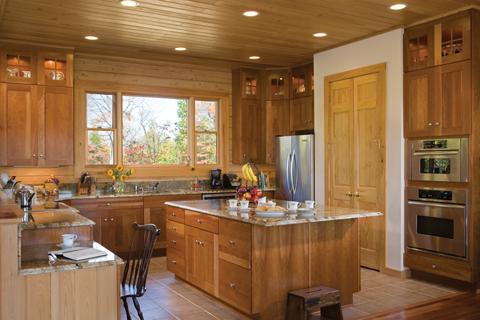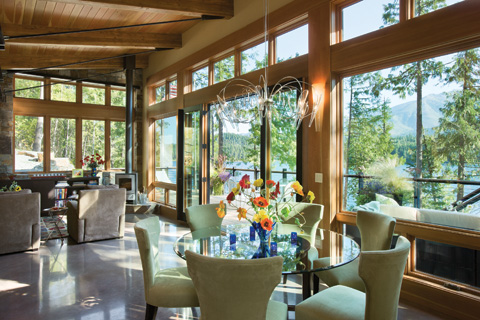The esteemed poet and author Maya Angelou once said, “I did then what I knew how to do. Now that I know better, I do better.”
What we know about energy efficiency has increased exponentially in recent years. So now that we know better, there’s no excuse for not doing better when it comes to homebuilding. Not only are energy-efficient building practices an important way to preserve the environment, they lead to a more comfortable home and can also save you money—preserving your bank account!
Of course, exactly how to do better might seem a little bit confusing. There are myriad resources to be found on the Internet to learn about energy-efficient building (start with energystar.gov!) but the best resource for your specific home project will likely be your builder. He or she will be up to date on the latest codes in your area and will have a good sense of what solutions are right for your home.
Log homes are inherently efficient in ways that conventionally built homes are not. For one thing, the solid log walls provide a stable thermal barrier while conventional walls are prone to gaps and inconsistencies in insulation. A 2010 Log Homes Council study found that log homes could be expected to be 2.5 to 5 percent more efficient than a conventional home of the same size.
Log homes also often have less of an impact on the environment because they require fewer resources to build, and the construction materials themselves require less processing.
Plan for the Big Picture
Let your builder know that energy efficiency is a priority for you from the very start of the planning process. If he or she does not have expertise in efficient building practices, consider bringing in a consultant to help during the planning phase. Talk with your builder (and energy consultant, if necessary) to get an understanding of what industry experts call the “thermal envelope.” The thermal envelope refers to the energy picture of the whole home. It is a way of looking at how all of the different elements tie together to result in a comfortable, efficient home.
Building an energy-efficient home starts before a single shovel hits the dirt on your property. In fact, one of the decisions that will have the biggest impact on your home’s energy consumption may be how you choose to orient your house on your property. Before making a final decision about your home’s orientation, be sure to consider things like the angle of the sun, exposure, and natural windbreaks.
Design Principles
Your home’s design can incorporate passive solar principles to keep it cool during the summer and warm during the winter while minimizing energy consumption. Besides orienting your house for optimal efficiency, consider strategically placed roof overhangs to add shade during the summer months when the sun is at its highest angle. This will still allow the sun’s warmth to get through the windows during the winter, when the sun is at a low angle.
You might also want to investigate a “cool” roof. These roofs are often light in color and made with materials that have “high solar reflectance.” This means that the roof material reflects sunlight rather than absorbing it, resulting in a savings of 10 to 15 percent on energy spending. Another benefit is that homes with cool roofs lead to less wear on the air conditioner, resulting in longer equipment life.
Whether a cool roof is right for you will depend on a few factors, including your local climate, whether your roof is pitched or flat, and whether you rely on air conditioning for much of the year. If you live in a cooler climate, a cool roof may not be worth the expense. No matter what kind of roof you choose, your log home will be more efficient if the joint between the top log and the roof is well sealed to prevent air leakage.
When selecting air conditioning equipment, it pays to select an HVAC system that is appropriately sized for your home. A system that is undersized will have to work overtime to keep your home comfortable, but you don’t want to waste money (and energy) on a system that’s oversized. Again, your home builder will be a great resource to help you determine the best size and efficiency.
To maximize savings, make sure ducts are sealed, and use a “smart” thermostat to make sure you’re not heating or cooling your home when you don’t need to. Don’t forget insulation! The type and material you choose to insulate your house will depend in large part on your climate. Be sure that you’re not cutting corners on insulation, and invest in proper installation.

BK Cypress Log Homes/photo by Roger Wade
Look Out
Windows, doors and sunlights—openings in your home’s shell that are sometimes collectively referred to as fenestration—can be notorious for air leakage. Don’t let these openings be points of weakness in your home!
Many log and timber homes have large windows to make the most of expansive views, so it’s important to choose the best windows you can afford. Look for high performance windows with Low-E (low emittance) coating, inert gas (like argon or krypton) between the glass panes to keep heat inside in the winter and outside in the summer, and window frames designed to minimize air leaks.
Doors are another area where you can lose warm air in the winter and let it in during the summer. Steel and fiberglass with an insulating foam core are popular choices for energy efficiency. But choosing efficient material is just one part of the equation; installation is equally important. The interfaces between log walls and window and door openings are areas that could lead to air leaks if installation is done improperly.
Some terms you might come across include U-factor, which is the rate at which a window or door conducts heat flow, and Solar Heat Gain Coefficient (SHGC), which refers to the amount of solar radiation admitted through a door or window. For the most efficiency, look for products that are EnergyStar® certified with a low U-factor. If you want to keep your home warm in the winter, a high SHGC might be better than a low SHGC, while those in warmer climates should opt for higher SHGC.
To qualify for EnergyStar® certification, products must meet specific standards set by the federal government. The standards are different depending on where you live in the country, so a window that is considered EnergyStar® certified in Arizona may not qualify in Wisconsin.
Lights & Appliances
EnergyStar® ratings can help you choose lights and appliances as well. There are so many choices on the market, and some areas even offer rebates on your energy bills for selecting efficient appliances. Appliances and lighting can account for more than one-third of your home’s total energy consumption, so it pays to do a little bit of research before you shop.
To reduce overall consumption, be thorough in your planning for lighting needs during the design phase. Consider the uses of each room in your home, take advantage of natural lighting, and where possible install recessed lighting that can be controlled by dimmer switches. Recessed lighting reduces heat output, which makes for a much more comfortable home!
Water fixtures are another concern. The Environmental Protection Agency’s WaterSense program certifies products to be 20 percent more efficient than traditional choices. These days, low-flow shower heads, faucets, and toilets perform as well as their high-flow counterparts so there’s no need to sacrifice performance. Toilets in particular can account for the majority of the water consumption in most homes, so it’s a good idea to choose the most efficient model you can find.
Modern manufacturing techniques make building a log home a sound and efficient choice. Log walls provide good thermal mass for your home, keeping temperatures relatively stable. If you take care with construction, avoid air infiltration, and make wise equipment and appliance choices, a log home can be built with consideration for the environment, your comfort, and your home’s durability.
Photography by Roger Wade Studio

